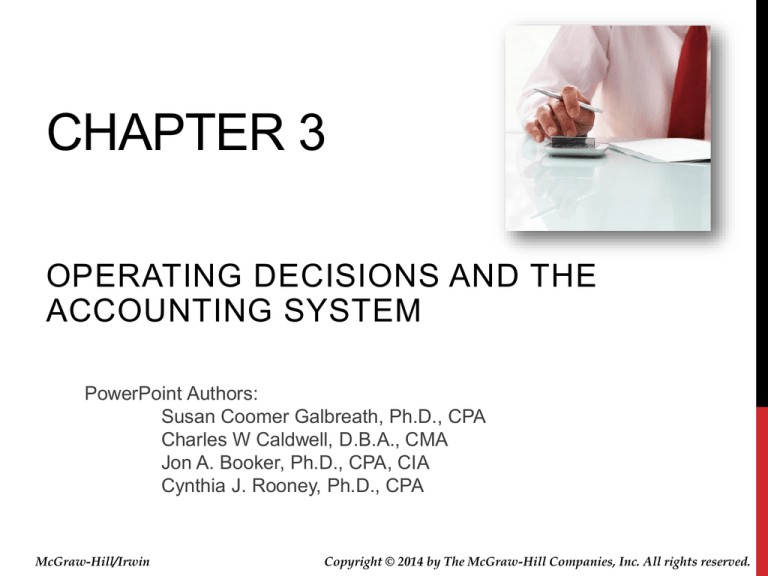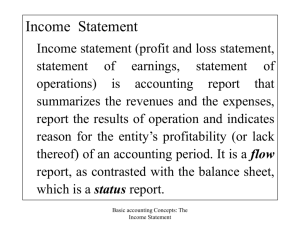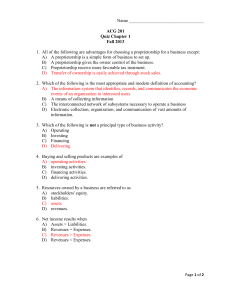
CHAPTER 3
OPERATING DECISIONS AND THE
ACCOUNTING SYSTEM
PowerPoint Authors:
Susan Coomer Galbreath, Ph.D., CPA
Charles W Caldwell, D.B.A., CMA
Jon A. Booker, Ph.D., CPA, CIA
Cynthia J. Rooney, Ph.D., CPA
McGraw-Hill/Irwin
Copyright © 2014 by The McGraw-Hill Companies, Inc. All rights reserved.
UNDERSTANDING THE BUSINESS
How do business activities
affect the income statement?
How are these activities
recognized and measured?
How are these activities
reported on the
income statement?
3-2
THE OPERATING CYCLE
3-3
THE OPERATING CYCLE
Time Period: The long life of a company can be
reported over a series of shorter time periods.
Recognition Issues: When should the effects of
operating activities be recognized (recorded)?
Measurement Issues: What amounts should be
recognized?
3-4
ELEMENTS ON THE INCOME
STATEMENT
Revenues
Increases in assets or settlement of
liabilities from ongoing operations.
Expenses
Decreases in assets or increases in
liabilities from ongoing operations.
Gains
Increases in assets or settlement of
liabilities from peripheral transactions.
Losses
Decreases in assets or increases in
liabilities from peripheral transactions.
3-5
3-6
OPERATING EXPENSES
An expenditure is any outflow of cash for any purpose,
whether to buy equipment, pay off a bank loan, or pay
employees their wages. Expenses are outflows or the
using up of assets or increases in liabilities from ongoing
operations incurred to generate revenues during the
period. Therefore, not all cash expenditures are
expenses, but expenses are necessary to generate
revenues.
3-7
RESTAURANT OPERATING
EXPENSES
1.
2.
3.
4.
5.
6.
7.
Food, Beverage, and Packaging Expense.
Salaries and Wages Expense.
Occupancy Expense.
Other Operating Expenses.
General and Administrative Expenses.
Depreciation Expense.
Income Tax Expense.
3-8
HOW ARE OPERATING ACTIVITIES
RECOGNIZED AND MEASURED?
Cash Basis
Revenue is recorded
when cash is received.
Expenses are recorded
when cash is paid.
3-9
HOW ARE OPERATING ACTIVITIES
RECOGNIZED AND MEASURED?
Accrual Accounting
Assets, liabilities, revenues, and expenses should be
recognized when the transaction that causes them
occurs, not necessarily when cash is paid or received.
Required by -
Generally
Acceptable
Accounting
Principles
3-10
REVENUE REALIZATION PRINCIPLE
Under the revenue realization principle, four criteria or conditions must normally be
met for revenue to be recognized. If any of the following criteria are not met,
revenue normally is not recognized and cannot be recorded.
1. Delivery has occurred or services have been rendered.
2. There is persuasive evidence of an arrangement for customer payment.
3. The price is fixed or determinable. There are no uncertainties as to the amount
to be collected.
4. Collection is reasonably assured.
3-11
EXPENSE MATCHING PRINCIPLE
The expense matching principle requires that costs incurred to
generate revenues be recognized in the same period—a matching
of costs with benefits. For example, when Chipotle’s restaurants
provide food service to customers, revenue is earned. The costs of
generating the revenue include expenses that are recognized in the
same period.
3-12
EXPANDED TRANSACTION ANALYSIS
MODEL
Assets = Liabilities + Stockholder’s Equity
ASSETS
LIABILITIES
Debit
Credit
for
for
Increase Decrease
Debit
Credit
for
for
Decrease Increase
Next, let’s see how
Revenues and
Expenses affect
Retained
Earnings.
CONTRIBUTED
CAPITAL
RETAINED
EARNINGS
Debit
Credit
for
for
Decrease Increase
Debit
Credit
for
for
Decrease Increase
3-13
EXPANDED TRANSACTION ANALYSIS
MODEL
Dividends decrease
Retained Earnings.
RETAINED
EARNINGS
Debit
Credit
for
for
Decrease Increase
Net Income increases
Retained Earnings.
REVENUES
EXPENSES
Debit
Credit
for
for
Decrease Increase
Debit
Credit
for
for
Increase Decrease
3-14
HOW ARE FINANCIAL STATEMENTS
PREPARED AND ANALYZED?
Income
Statement
Statement of
Stockholders’
Equity
Balance
Sheet
Statement
of Cash Flows
Revenues – Expenses = Net Income
Beginning Retained Earnings
+ Net Income
- Dividends Declared
Ending Retained Earnings
Assets = Liabilities + Stockholders’ Equity
Contributed Capital
Retained Earnings
Change =
Cash from Operating Activities
in
+ Cash from Investing Activities
Cash
+ Cash from Financing Activities
3-15
HOW ARE FINANCIAL STATEMENTS
PREPARED AND ANALYZED?
Income
Statement
Statement of
Stockholders’
Equity
Balance
Sheet
Statement
of Cash Flows
Revenues – Expenses = Net Income
Beginning Retained Earnings
+ Net Income
- Dividends Declared
Ending Retained Earnings
Assets = Liabilities + Stockholders’ Equity
Contributed Capital
Retained Earnings
Change =
Cash from Operating Activities
in
+ Cash from Investing Activities
Cash
+ Cash from Financing Activities
3-16
TRIAL BALANCE
Debits and credits are equal
after preparing the
unadjusted trial balance.
3-17
INCOME STATEMENT
The following classified
income statement is
presented to highlight the
structure but note that,
because it is based on
unadjusted balances, it would
not be presented to external
users.
3-18
NET PROFIT MARGIN
Net
Profit
Margin
=
Net Income
Net Sales (or Operating Revenues)*
* Net sales is sales revenue less any returns from customers and other
reductions. For companies in the service industry, total operating revenues
is equivalent to net sales.
The 2011 ratio for Chipotle using actual
reported amounts is (dollars in thousands):
3-19
FOCUS ON CASH FLOWS
Companies report cash inflows and outflows over a period of time in their statement of cash
flows that is divided into three categories:
O - Operating activities primarily with customers and suppliers, and interest payments and
earnings on investments.
I - Investing activities include buying and selling noncurrent assets and investments.
F - Financing activities include borrowing and repaying debt, including short-term bank
loans, issuing and repurchasing stock, and paying dividends.
3-20
END OF CHAPTER 3
3-21






